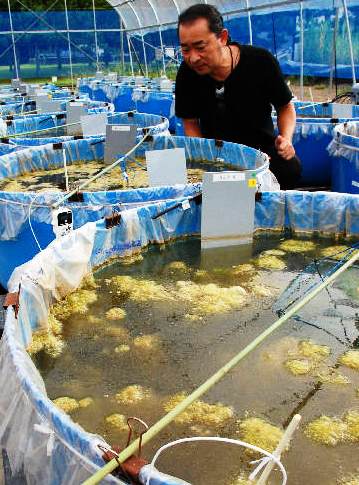The Environment Ministry is working on reducing pesticides’ damages caused on wildlife living in rice fields, such as dragonflies and killifish, by adjusting pesticide application in terms of ingredients and application period.

Koichi Goka, chief researcher of the National Institute for Environmental Studies at Tsukuba, Ibaraki Prefecture, looks into one of the pools used for mesocosm experiments.
At the ministry’s National Institute for Environmental Studies in Tsukuba, Ibaraki Prefecture, a research group headed by chief researcher Koichi Goka is conducting mesocosm experiments, a method of using enclosed pools of rice fields to create a semi-natural environment and evaluate the impacts of pesticides by realistically manipulating ecosystems unique to each region.
The research group placed rows of blue, washtub-like pools which are one meter in diameter and 80 centimeters deep, and applied different types of pesticides, mainly insecticides, at different levels of concentration to each pool.
Goka says that mesocosms enable them to scientifically evaluate the influences of pesticides on the actual biodiversity, which is not possible in pesticide registration tests conducted in small laboratory beakers.
Through the experiments, the group analyzed such factors as the temperature and muddiness of the water, the amount of pesticide residues and the conditions of planktons and soil animals, to see how pesticides spread and decompose, and how much damage they give on wildlife at different stages. They found out that creatures such as dragonfly nymphs, planktons and nonbiting midges are especially influenced by the use of pesticides.
For the past three years, the ministry has been working on developing a simple method for municipalities and agricultural cooperatives to evaluate the impact of pesticides, so that they can take measures to protect biodiversity in each region. The ministry plans to create a draft manual by the end of fiscal 2013, and starting in the next fiscal year, it will compile manuals specifically designed for each region, based on surveys by local agricultural experiment stations and universities.
The ministry officials said they also plan to revise the guideline for pest control, including changing the pesticide spraying period and the type of pesticides applied to seedling raising boxes, taking into consideration different biological communities.
(Aug. 14, 2013)

